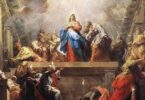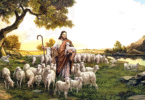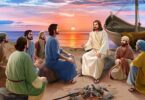Scripture: Acts 15:1-2, 22-29; Ps. 67:2-8; Rev. 21:10-14, 22-23; Jn. 14:23-29
As we approach the end of the Easter season, we continue to uncover the
profound truths of our Christian faith revealed throughout these holy days. Each
Sunday of Easter deepens our understanding of the mystery of the Resurrection
and its transformative impact on the lives of believers—especially in how we
understand God’s dwelling among us.
The resurrection of Jesus brought about a new awakening for His first
followers, who were primarily Jewish. Raised in the Jewish tradition, they were
deeply familiar with the idea of God dwelling among His people, especially
through the tabernacle and later the Temple in Jerusalem. However, in the light
of the Resurrection, they came to a deeper realization: the Risen Lord now
makes His permanent dwelling among His people. No longer was God distant
or confined to a sacred building—His presence was now alive in the midst of
the believing community. This gave the disciples great courage and peace. They
had nothing to fear, for the Risen Christ was with them.
The Old Testament shows a gradual development in the understanding of God’s
presence. The patriarchs—Abraham, Isaac, and Jacob—encountered God in
visions and dreams. During the Exodus, God instructed the people to build a
tabernacle so that He might dwell in their midst: “Let them make me a
sanctuary, that I may dwell in their midst” (Exodus 25:8). This portable
sanctuary housed the Ark of the Covenant and became the visible sign of God’s
presence. When the Israelites finally settled in the Promised Land, King
Solomon built the first Temple in Jerusalem to replace the tabernacle. The
Temple was regarded as God’s permanent earthly dwelling. However, after its
destruction in 586 BC, prophets such as Isaiah, Jeremiah, and Ezekiel began to
teach that God’s presence was not limited to a building. They pointed to a time
when God would dwell among His people in a new and everlasting way.
In the Gospel proclaimed today, Jesus speaks to His disciples during His final
discourse. He fulfills the longings expressed by the prophets and reveals that
both He and the Father will come and dwell with those who love His word. This
marks a significant shift in the understanding of God’s dwelling. No longer
limited to a sacred structure, God now wishes to dwell in the hearts and lives of
His people. Jesus even uses the plural pronoun “we” to show that it is the entire
Trinity—Father, Son, and Holy Spirit—who comes to abide in us. Furthermore,
all the elements once associated with the Temple—peace, joy, holiness—are
now to be experienced within the person who believes. Jesus identifies Himself
as the true Temple when He says, “Destroy this temple, and in three days I will
raise it up” (John 2:19). After the Resurrection, the disciples finally understood
that Jesus had become the new and eternal dwelling place of God.
This theme continues in the Book of Revelation, where St. John offers a
glorious vision of the New Jerusalem. He sees a magnificent city, radiant with
God’s glory, adorned with walls, gates, and angelic guardians. Yet one detail
stands out: there is no temple in the city. John writes, “I saw no temple in the
city, for its temple is the Lord God Almighty and the Lamb” (Revelation 21:22).
This vision reveals that there is no longer any need for a physical temple,
because God is now fully and perfectly present everywhere. There is no need
for altars, priests, or sacrifices, because Jesus Himself is the eternal priest and
perfect sacrifice. The New Jerusalem itself—radiant with divine light—has
become the holy temple, the perfected Church.
This vision of the New Jerusalem deeply inspired the early Church Fathers. St.
Augustine, in his great work City of God, described the New Jerusalem as the
Church perfected in glory. St. John Chrysostom referred to the Church as “the
city of the King” and “a heaven on earth.” These Fathers, drawing from the
Apostolic witness, saw in the death and resurrection of Christ the fulfillment of
God’s plan to unite Jews and Gentiles as one people (cf. Ephesians 2:14–15).
The Church, born from the side of Christ and animated by the Spirit at
Pentecost, becomes the new and everlasting dwelling of God among His people.
Today’s first reading gives us a glimpse of how the early Church recognized this
presence. In a moment of disagreement over whether Gentile converts should be
circumcised according to Jewish law, the apostles gathered in prayer and
dialogue. After discernment, they chose not to burden the Gentiles with this
requirement, affirming that faith in the Risen Lord was sufficient. Their
decision, made under the guidance of the Holy Spirit, is one of the first clear
signs that the early Church recognized God’s dwelling not in ritual observance,
but in the shared life of the believing community.
As we reflect on these profound truths, may we recognize that we, the Church,
are now the dwelling place of God. In the Risen Christ, the Triune God has
made His home in us. With joy and thanksgiving, let us join the psalmist in
praising God: “May the peoples praise you, O God; may all the peoples praise
you!” (Psalm 67:5)






